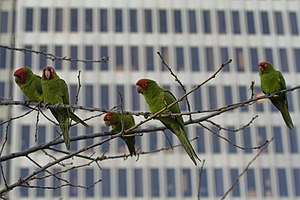Feral parrot: Difference between revisions
No edit summary |
|||
| Line 95: | Line 95: | ||
==External links== |
==External links== |
||
*[http://cityparrots.org/ Feral, Naturalized & City Parrots] |
*[http://cityparrots.org/journal/category/urban-parrots Feral, Naturalized & City Parrots] |
||
*[http://www.californiaparrotproject.org/lilac_crowned_parrot.html California Parrot Project] |
*[http://www.californiaparrotproject.org/lilac_crowned_parrot.html California Parrot Project] |
||
*[http://www.brooklynparrots.com/ BrooklynParrots.com (Chronicles wild Monk Parrots in Brooklyn)] |
*[http://www.brooklynparrots.com/ BrooklynParrots.com (Chronicles wild Monk Parrots in Brooklyn)] |
||
Revision as of 14:31, 9 October 2011

A feral parrot is a parrot that has adapted to life in an ecosystem to which it is not native.
Parrots living in non-native environments
Rainbow Lorikeet
Feral colonies of Rainbow Lorikeet (Trichoglossus haematodus) have been established in Perth, Western Australia[1] and in Auckland, New Zealand.
Eastern Rosella
The Eastern Rosella (Platycercus eximius) has become naturalized in the North Island of New Zealand.[2]

Rose-ringed Parakeet
A sizeable population of naturalized Rose-ringed Parakeets (Psittacula krameri) exists in and around cities in England, the Netherlands, Belgium and western and southern Germany. The largest UK roost of these is thought to be in Esher, Surrey, numbering several thousand. Feral Rose-ringed Parakeets also occur in the United States, South Africa, Israel, Lebanon, UAE and Oman.
Other
Also found in the United States are various naturalized Brotogeris spp. (mainly B. versicolurus (Canary-winged Parakeet a.k.a. White-winged Parrot) and/or B. chiriri (Yellow-chevroned Parakeet/Parrot).
Brooklyn (in New York City), Austin, Texas and Miami, Florida are home to populations of Myiopsitta monachus (monk aka Quaker Parakeet/Parrot).[3]
A population of naturalized Rose-collared (a.k.a. Peach-faced Lovebirds) (Agapornis roseicollis) is found in Tucson, Arizona.
Several species, including Red-lored Parrots (Amazona autumnalis), Lilac-crowned Parrots (Amazona finschi) and Yellow-chevroned Parakeets (Brotogeris chiriri), have become well established in Southern California and a population of mainly Red-masked or Cherry-headed Parakeet/Conure, a female Mitred Parakeet/Conure and thus several inter-specific hybrids live in the area of Telegraph Hill in San Francisco, as depicted in the documentary The Wild Parrots of Telegraph Hill.
The Belmont Heights District in Long Beach, California is also known to have many different species of feral parrots which have become local icons to the citizens of the area. They are known for their loud and unique noises as well as their large communities. These parrots can be found roosting mostly on Ocean Boulevard between Livingston Drive and Redondo Avenue in palm trees.
Pasadena, California has a large, non-indigenous population of naturalized parrots. According to the "Parrot Project of Los Angeles",[4] the parrots are of at least five species.[5][6] Residents have come to enjoy the birds as part of their unique city's culture,[7][8] and like other SoCal residents they have become "local icons" to the citizens there.[9] Many theories surround the mystery of how the parrots landed in Pasadena and claimed the area as their own.[10] A widely accepted story is that they were part of the stock that were set free for their survival from the large pet emporium at Simpson's Garden Town on East Colorado Boulevard, which burned down in 1959.[6][11]
Lists of feral parrot species by continent
North America

- Budgerigar
- Blue-and-gold Macaw
- Rose-ringed Parakeet
- Monk Parakeet
- Canary-winged Parakeet
- Yellow-chevroned Parakeet
- Peach-faced Lovebird
- Red-lored Amazon
- Lilac-crowned Amazon
- Yellow-chevroned Parakeet
- Red-masked Parakeet
- Hybrid Mitred Parakeet
- Red-crowned Amazon
- Nanday Parakeet
South America
Note: Species found as introduced to the State of Rio de Janeiro, outside their historical ranges;[12] further research can detect other species in other regions.
Europe
Africa
Middle East
New Zealand
Asia
Causes
Feral parrot flocks can be formed after mass escapes of newly-imported, wild-caught parrots from airports or quarantine facilities. Large groups of escapees have the protection of a flock and possess the skills to survive and breed in the wild. Some feral parakeets may have descended from escaped zoo birds.
Escaped or released pets rarely contribute to establishing feral populations. Escapes typically involve only one or a few birds at a time, so the birds do not have the protection of a flock and often do not have a mate. Most captive-born birds do not possess the necessary survival skills to find food or avoid predators and often do not survive long without human caretakers. However, in areas where there are existing feral parrot populations, escaped pets may sometimes successfully join these flocks.
The most common era or years that feral parrots were released to non-native environments was during the 1890s to the 1940s, during the wild-caught parrot era.
In the Psittacosis "parrot-fever" panic of 1930, "One city health commissioner urged everyone who owned a parrot to wring its neck. People abandoned their pet parrots on the streets."[13]
Environmental impact
Some bird experts and governments[who?] are afraid that the feral parrots may in fact harm native bird populations. In some places, extermination programs have been implemented, and certain species have been banned as pets.[citation needed]
References
- ^ Chapman, Tamra. (2006): The status, impact and management of the feral Rainbow Lorikeet (Trichoglossus haematodus moluccanus) in south-west Western Australia. Eclectus 16-17: 17-18.
- ^ Falla RA, Sibson RB & Turbot EG (1966) A Field guide to the birds of New Zealand. Collins, London (ISBN 0-00-212022-4)
- ^ BrooklynParrots.com
- ^ Parrot Project of Los Angeles
- ^ The California Parrot Project
- ^ a b City of Pasadena, Pasadena Facts, Parrots
- ^ Pasadena Parrots Enjoy Spring
- ^ The Parrots of Pasadena | SoCalRunning.com
- ^ Weird California - Pasadena Parrots
- ^ Wild Parrots in Pasadena? Yep! by Scott's L.A. Audio CD Tours
- ^ Wild Parrots Crowd Other Birds in L.A. - ABC News
- ^ José Felipe Monteiro Pereira, Aves e Pássaros comuns do Rio de Janeiro, Rio de Janeiro, Editora Tachnical Books, 2008, ISBN 978-85-61368-00-5, pgs. 63,66 and 68
- ^ Lepore, Jill (1 June 2009). "It's Spreading". The New Yorker. New York: 27–29. Retrieved 13 September 2011.
